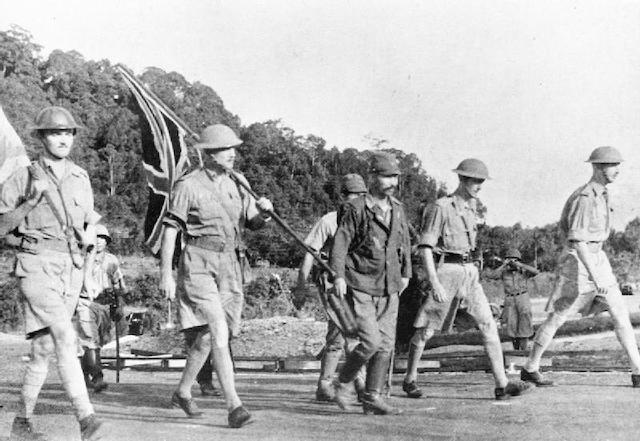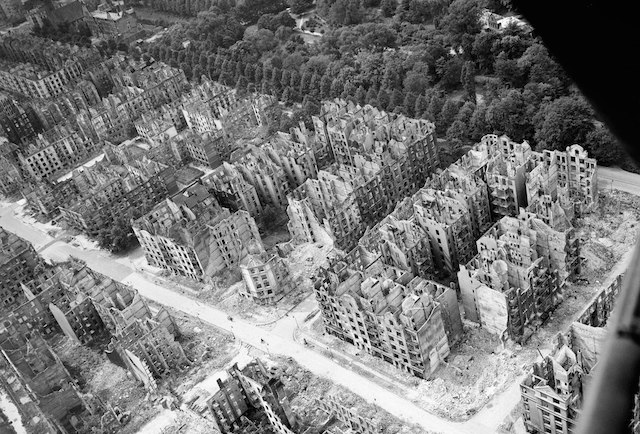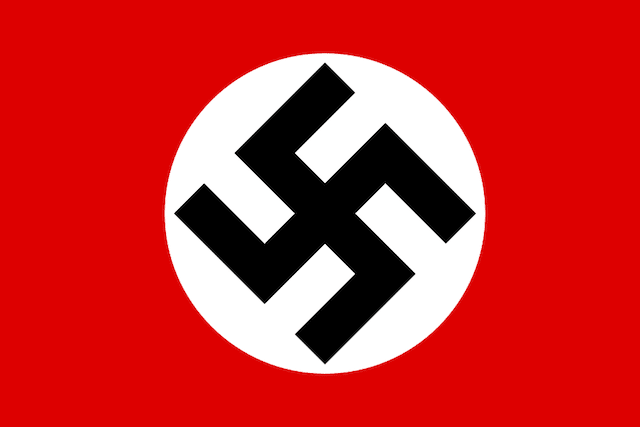The Second World War was perhaps the most destructive war in history. Some official reports put the death toll close to 60 million , although the actual death toll may be much higher. Not all died in combat—more than 45 million were civilians, as ordinary people around the world bore the brunt of a war that would become famous for its extraordinary scale and brutality.
10. The Chichijima Incident

Cases of cannibalism were reported throughout the war, particularly on the Eastern Front where the fighting was particularly brutal. Most were motivated by necessity, as during the siege of Leningrad, when thousands of people began to eat human flesh due to hunger and severe cold.
However, in some rare, horrific cases, cannibalism was also practiced simply for fun. One particularly infamous case was the Chichijima incident, in which eight American airmen were captured, tortured, and killed with bamboo sticks. Four of the men were then eaten by Japanese officers. According to their testimony during post-war tests, the meat were preparing with soy sauce and vegetables - one officer even thought it was good for stomach In one fascinating turn of events, there was actually a ninth airman who managed to evade capture: a 20-year-old pilot named George H. W. Bush.
According to later records and eyewitness accounts, this was not an isolated incident. The Chichiyama incident was just one of many cases of cannibalism committed by Imperial Japanese troops in Pacific theater military action, often against prisoners of war and occupied civilian populations.
9. The Gardelegen Massacre

While Nazi atrocities continued throughout the war, some of the most horrific massacres occurred in its final stages. As the Red Army and Western Allied forces invaded Germany, large-scale efforts were made to hide evidence of the crimes, either by killing thousands of prisoners still living in concentration camps or forcing them on long death marches to camps closer to Berlin.
Gardelegen was one such camp, about 90 miles west of Berlin, where more than 4,000 prisoners arrived from different parts of Germany. 13 April 1945 more than 1,000 of them were taken to a barn, barricaded inside, and set on fire with gasoline and flamethrowers. Almost all the victims, majority of which were Poles , were burned alive or shot, except for six survivors who were rescued by advancing Allied troops just two days after the massacre.
8. Kaunas pogroms
Anti-Jewish pogroms in Kaunas, Lithuania, began almost immediately after Germany invaded the Soviet Union on June 22, 1941, ushering in a horrific chapter of the Holocaust that is now largely forgotten. Unlike the industrialized, almost indifferent methods used in German death camps, the violence in Lithuania and other eastern territories was far more personal, often taking the form of beatings with blunt weapons and violent public executions.
The most infamous incident was the Letkis garage massacre, which began on June 27 when about 60 Jewish men were beaten to death with scrap metal by local Lithuanian nationalists. According to an eyewitness report by a German photographer, the main perpetrator was a man nicknamed the Trader Death , as the crowd, consisting of German soldiers and local Lithuanians, applauded and cheered throughout the entire event.
7. Bengal Famine
The Bengal famine of 1943 was one of the greatest disasters of the war, killing more than 3 million people in the Indian state due to widespread famine and disease. Many factors contributed to this, especially the military events of 1942. When British strongholds in Singapore and Myanmar fell to Japan, food exports from there ceased, coupled with crop diseases and natural disasters that reduced overall harvests.
Some more recent studies, however, suggest that it was not a lack of supplies that caused the famine, as the 1943 harvest was still sufficient to feed the entire local population of Bengal. Food supplies were being diverted from the province to support the war effort in the Middle East or were being stockpiled in special wartime warehouses, creating shortages and inflation for the local population. Fearing a Japanese invasion, the provincial government confiscated vast quantities of rice and thousands of fishing boats across Bengal, damaging the region's food transportation system.
6. Odessa massacre 1941
The Ukrainian city of Odessa was occupied by Nazi-backed Romanian troops on October 16, 1941, after more than two months of fierce fighting against Soviet forces. On October 22, one of the occupied buildings was blown up by a remote-controlled mine, possiblypledged by the Red Army before the occupation. The explosion killed 67 people, including the Romanian military commandant and a number of Romanian and German officers.
In retaliation, Romanian soldiers and SS death squads, allied with local ethnic German groups, carried out a bloody massacre of the local Jewish population, beginning a dark chapter of the Holocaust that is now little spoken of. More than 30,000 Jewish citizens of Odessa were rounded up in barracks, prisons, and makeshift camps and murdered on October 22 and 23. Many were locked in warehouses and burned alive – the smell of burning bodies lingered in the air, according to eyewitnesses. day .
The Odessa massacre in 1941 was just one of many crimes committed by Romanian troops on the eastern front. 410 000 people were killed in Odessa and the surrounding Transnistria region throughout the war, often as a result of forced starvation, exhaustion and extreme cold.
5. Warsaw

The Warsaw Uprising began on August 1, 1944, when members of the Polish resistance Home Army launched a coordinated attack on the occupying Axis forces through Warsaw. In response, Hitler issued the Warsaw Order that same day, directing his forces in Poland to completely destroy the city and exterminate its population.
What followed was the complete and utter destruction of one of Europe's most prosperous cities before the war, as every building in the city was systematically razed to the ground by Nazi troops. Despite some early successes, the uprising was eventually crushed. Many Warsaw residents were burned alive in the ensuing massacre, and many more were lined up and machine-gunned.
The violence took a particularly ugly form in the Okhota district, where collaborationist The Russian National Liberation Army (RONA), made up of captured Russian soldiers and former prisoners, systematically killed everyone they could find. Many women were raped and then publicly burned alive , as the violence claimed the lives of at least 10,000 people.
4. Siege of Leningrad

When German and Finnish troops laid siege to the Russian city of Leningrad (now St. Petersburg) on September 8, 1941, they did not expect much resistance. It was still the early phase of the Axis advance into Russia, as the Red Army was in retreat with heavy losses along the entire front. A quick capture of the city—at the time one of the crown jewels of the Bolshevik empire—would boost morale and give the Axis a strategic point from which to launch further attacks.
Little did they know, however, that it would prove to be the most grueling and protracted battle they had ever fought. It was the longest and perhaps most destructive blockade of a civilian population in history, lasting a total of 872 days The city was constantly bombed by German artillery and Luftwaffe bombers, often using incendiary munitions that set parts of the city on fire.
With the onset of the harsh winter of 1941-42, the famine turned into an epidemic, so as a result of acute food shortages the city was losing more than a month 100 000 Human. Local police arrested more than 2,000 people for cannibalism, although the actual number was likely much higher.
Leningrad was finally liberated by the Red Army on January 27, 1944. By the time it was over, the city's population had been reduced from 2.5 million to 800,000, making it one of the deadliest sieges in history.
3. The Fall of Singapore

The British stronghold of Singapore fell to Japan on 15 February 1942, in what remains the largest capitulation British troops in history. Over the next two weeks or so, Imperial Japanese troops carried out a systematic campaign to exterminate the city's Chinese population and other people deemed undesirable to Japan's war effort.
Somewhere between 5,000 and 50,000 people were killed during the purge, now remembered as Sook Ching , which translates as "cleansing through cleansing," among the Chinese community in Singapore. Anti-Chinese sentiment among Japanese soldiers was fueled by the grueling battle front in China, as about 10-20 percent of the local Chinese population was killed by machine guns, beheadings, with bayonets , explosions and other violent methods during the massacre.
2. Bombing of Hamburg

On July 24, 1943, at around 1 a.m., British and American bombers began a terrifying firebombing of Germany’s second-largest city at the time, Hamburg. Armed with explosives and a host of newly developed incendiary bombs, the operation, codenamed Gomorrah, was a terrifying turning point in the war. It was the first of many Allied operations aimed at civilian centers and other non-military targets in German and Japanese cities—a strategy that would be repeated on a larger scale in Dresden, Tokyo, and eventually Hiroshima and Nagasaki.
The raids continued for more than a week, subjecting the people of Hamburg to a level of terror never experienced before. The worst of it came on July 27, when the bombs created a massive firestorm that burned thousands alive in a matter of hours. Street temperatures reached 1,400 degrees Fahrenheit and winds exceeded 170 miles per hour, burning down some 16,000 buildings, home to more than 450 000 people. British pilots flying higher even reported turbulence and a strong stench of burning flesh from the storm. By the time it was over, at least 37,000 people had died as in a few days, Hamburg was hit more 9 000 tons of bombs.
1. Aktion T4

IN In 1933 The German government has passed the Law on the Prevention of Hereditary Diseases of Offspring , which made sterilization mandatory for anyone with what were then considered genetic diseases. Between 1933 and 1939, more than 360,000 people with illnesses such as schizophrenia, epilepsy, and even alcoholism were sterilized in camps converted from prisons, hospitals, schools, and other buildings across Germany.
This was only the beginning of a long and horrific process to eliminate what the Nazis considered undesirable ailments from the German gene pool, which eventually led to the T4 program. after The outbreak of war in 1939, it was a mass euthanasia program conducted at six sites in Germany and Austria using methods that were later replicated on a much larger scale during the Holocaust. At first, T4 involved only infants and toddlers, although it was soon expanded to include adults with disabilities and mental illnesses. Although the program was officially ended in 1941, the killings continued throughout the war years, claiming the lives of about 250 000 man to its end.













Оставить Комментарий